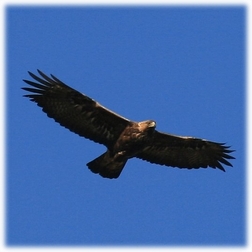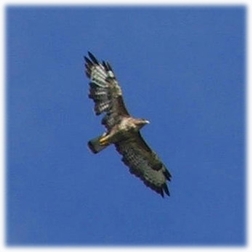Home
Golden Eagle or Buzzard?
How to tell a Golden Eagle from a Buzzard
 |
 |
| Photographer: Carl Reavey |
Photographer: Graham Wallace |
Both are exciting and impressive in
flight and soaring at a distance they can be confused. One way
of telling them apart is size. The Golden Eagle with its wing
span of six to seven feet is a huge bird of prey. The smaller
Buzzard has a wing span of around four feet. If you see a
distant bird of prey being mobbed by other birds like crows,
ravens, and gulls and, in size, that bird absolutely dwarfs
these birds then it is likely to be a Golden Eagle. In contrast the
Buzzard is a more similar size to these species.
In addition, the Golden Eagle with its long broad wings and
longish tail has a different outline to the smaller Buzzard which
has rounded wings and a short neck and tail. (See illustrations)
The Buzzard often perches on exposed telegraph poles and in
trees. Its plumage can be very variable from pale to dark brown.
Close up views are impressive.
Or
this article from Walk Highlands website
Eagle or
buzzard?
Locals who live in
Scotlandís eagle hotspots sometimes refer to buzzards as Ďtourist eaglesí. Itís
understandable, because of all the identification mix-ups in the natural world
the buzzard/eagle confusion is a classic. Personally I attribute it to a
combination of three things:
1. Some buzzards
really are quite large.
2. People donít
realise just how enormous eagles are.
3. People REALLY
want to see an eagle.
Itís hard to gauge
size when youíre staring up at something but eagles really are ENORMOUS. So
enormous that their size makes you stop and stare as though youíve seen a
pterodactyl flying overhead. The golden eagle has a huge 7ft wingspan, the
white-tailed eagle has an insane 8ft wingspan, but the buzzard comes in at a
mere 4ft. If in doubt just ask yourself, ďis that bird as wide as Darth Vader is
tall?Ē
Another helpful
feature is that both of the eagles have very long and obvious Ďfingersí (primary
feathers) at the end of their enormous wings. Buzzards have Ďfingersí too but
theyíre much shorter and, more often than not, are so close together that
theyíre hidden from view.
Itís often said
that if you have to stand and ponder whether or not a bird is an eagle, it
probably isnít.
Golden or
White-tailed?
After youíve
successfully confirmed itís an eagle and not a buzzard your troubles are only
just beginning Iím afraid, because telling Scotlandís two species of eagle apart
can be frustratingly difficult.

Youíd think the
names might get you started but sadly not. Golden eagles arenít necessarily
golden, white-tailed eagles donít necessarily have white tails, and Ďsea eaglesí
are sometimes seen in the mountains.
Add to that the
plumage differences between adults and juveniles and the fact that some golden
eagles are coastal birds, and youíve got something of a challenge on your hands.
Donít despair, though, because they are different in appearance.
The sightings most
of us are likely to get are those either from afar or from below. Silhouettes
and profiles rather than close-ups in full colour. In those circumstances the
size and outline of the wings and tail are the best things to go by.
White-tailed
eagles are sometimes called Ďflying barn doorsí because of their starkly
rectangular shape. Golden eagles ≠have a similarly impressive silhouette but it
doesnít look so plank-like. Itís got more curves to it and the wings arenít as
broad.
Golden eagles have
small heads relative to their longer tails, while white-tailed eagles have large
heads relative to their shorter, usually diamond-shaped tails.

Another reliable
thing to look for is the angle the wings are held at when the birds are soaring.
White-tailed eagles hold their wings flat in an almost straight line whereas
golden eagles soar with their wings raised into a slight V-shape.
Bear in mind that
these are only very general guidelines, as an eagleís appearance and outline can
change depending on what itís doing. There are plenty of other things to look
for, and
this handy and brief picture guide from the RSPB neatly sums up the
differences between eagles and buzzards.
If after a
sighting youíre still unsure about what you saw, thereís no shame in falling
back on the opinions of people more proficient or experienced than you. I
certainly donít hesitate to do so, as eagles arenít things I see every day!
Becoming proficient at any wildlife identification requires regular practise,
and thatís not something most of us can expect to get with creatures as
relatively scarce as eagles.
Many thanks to
wildlife artist Karen Hartnell for her valuable insights about eagle
identification.
Home



